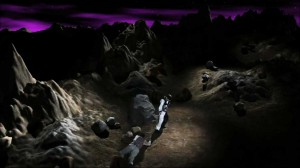
Co-director Glenn Holsten chose DIVE for DI, visual effects, sound mix and editorial hosting to complete OC87, which premiered at the Philadelphia Film Festival and today opens in Los Angeles.
OC87: The Obsessive Compulsive, Major Depression, Bipolar, Asperger’s Movie is a critically-acclaimed documentary about Bud Clayman and his struggle with “harm OCD,” which is marked by intense anger and violent feelings toward others. The title of the film refers to the year in which Clayman was at his worst – almost completely paralyzed by depression and at the height of his disorder, he withdrew from society. The documentary captures Clayman’s attempts to explain the disorders he deals with every day, and how he learns to manage them in order to improve his life.
OC87‘s Holsten wanted a team who could guide the filmmakers through the technical process of editing a film shot on multiple formats while still putting Clayman at ease. The directors set up editorial within DIVE and had firsthand access to its technical staff, bringing them in for creative consultation especially for VFX work.
“We wanted the film to be real, but artfully portrayed with the polish that only DIVE could give us,” said Holsten.
DIVE’s main focus was on effects for a sequence based on an old Lost in Space episode. The scene, composed of 21 shots, features Clayman as a character from the vintage TV series who is tortured by his evil counterpart.
The collaboration between Clayman, Holsten and the team at DIVE is a perfectly matched example of the genre.
“Kevin created the world, and DIVE’s input was crucial,” Holsten explained. “DIVE VFX supervisor Mark Forker looked at our storyboard and guided us. His experience with visual effects led us to do as much in-camera work as possible – like using a real dirt floor for the Lost In Space scene – giving us the look we wanted while heading off any potential editing difficulties.”
DIVE 3-D artist Kevin Fanning designed the look of the foreign planet, and Ed Mendez managed the team of artists to complete the sequence with the look and feel of the era.
“Lost in Space had that campy 1960s theatrical look and the practical set pieces replicated that vibe,” Fanning said. “We shot in studio on greenscreen with a 15-foot section of dirt and a paper rock, so we needed to blend the practical with the digital in an over-the-top look.”
Using LightWave 3D, Fanning created the rock terrain to fit with the set and match the practical rock, blending it all with 3-D work. The wide shot was complicated because DIVE needed to combine the practical environment with a digital environment that included matching practical lightning flashes in a flickering pattern throughout the digital scene. DIVE also generated the sky backgrounds behind Clayman including stars and nebulous space bodies.
“Glenn and Buddy really did their homework on the look they wanted, so it was a great scene to work on,” said Fanning. “They were so clear with their idea that executing a look similar to Lost In Space was straightforward and fun.”
Clayman was an aspiring filmmaker in his teens and early twenties, studying film production at Temple University when his symptoms came to the forefront. The film is a labor of love for him and his team, taking four years to complete.
“The team at DIVE provided a strong guiding hand and was so unfailingly positive that it gave our project a family feel and provided a safe environment for Buddy,” says Holsten. “[DIVE executive producer] Andy Williams was extraordinary. He not only anticipated our needs throughout but also assembled a team that approached our subject with sensitivity.”





